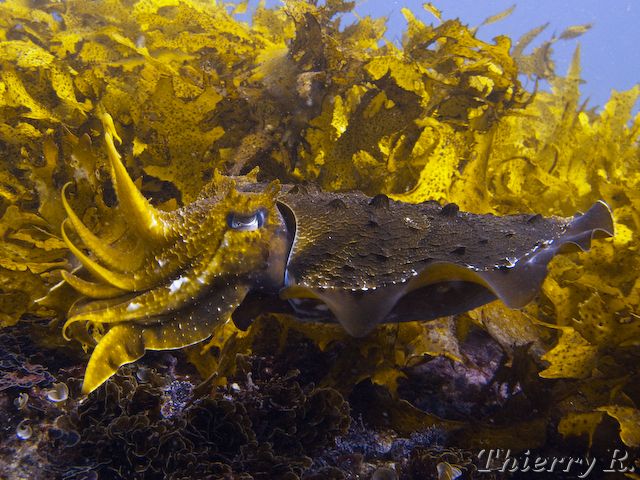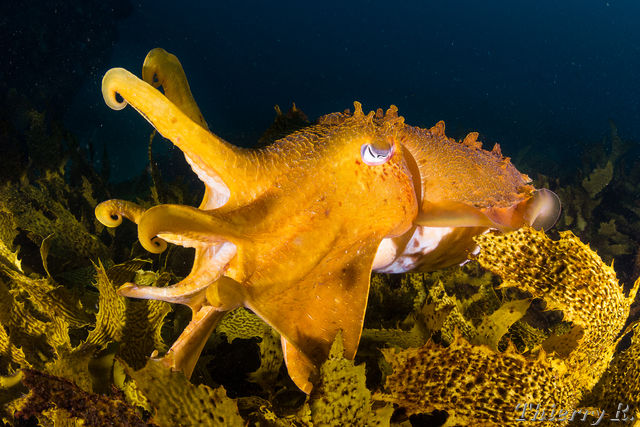Adaptations
The Australian Giant Cuttlefish has many adaptations that help it
survive. One of these is its ability of camouflage to hide from
predators. Chromatophores (pigments in the skin), papillae (which
add texture) and leucophores are used in conjunction with each other
in order to create extremely elaborate effects. The camouflage
coordinates with the surrounding, as observed by pupils whose
parameters allow it intensive planar focusing as well as senses in
the body that allow the cuttlefish to register how much light is
being absorbed in order to give off a similar light. The skin of
the cuttlefish has three layers of pigmented skin cells that possess
yellow, red, and brown colors. These cells are in sacs which can be
stretched with muscles in order to show more or less of each color.
Under that is an iridescent layer of reflecting cells, iridophores,
with blue, green, red, and pink. Leucophores produce the white
color. They may change their color and pattern to hide in the reefs
and rocks from predators. The skin has papillae which allow a rigid
appearance, representative of coral (Zylinski et al, 2011).
To see this in action, check out this
video! As
the divers follow the cuttlefish, you can see it change color and
texture to look more like the seagrasses and ocean floor that it is
passing through.
Another
adaptation that the Sepia apama has is the ability to move their
eye further from or closer to the retina. They have muscles which
contract and expand the tissue around the pupil, similar to the
action of the pigments in the skin (Marshall et al, 1996). This
feature of the eye gives the ability to see prey and predator alike
at varying distances, not to mention the environment with which it
will at some point blend with. The eye has direct nerve control, as
soon as information comes from the eyes to the brain, the brain
sends signals directly to the skin in order for the skin to change
colors to correlate with the cuttlefish’s surrounding. This happens
instantaneously.
When stalking
prey, the cuttlefish will use its advanced camoflauge to sneak up
close, If the prey isn’t fooled by the camouflage and is alarmed to
the presence of a cuttlefish, the cuttlefish will stop trying to
blend with the environment and will flash colors in order to daze
the prey. They literally look like a strobe light. They will also
use the ability of jet propulsion to give it extreme bursts of speed
in the water. In order to escape predators, the cuttlefish can also
spray ink in the predators face.
The Sepia
apama has eight arms and two tentacles. The arms have suckers all
along their length while the tentacles only have suckers at the
tips. The tentacles are generally hidden and are used to snag prey,
which is lured by the arms. The arms are used to make the
cuttlefish appear larger than life when necessary, such as when a
potential predator is lurking (Encyclopedia of Life, 2013).
Check out how they reproduce!

